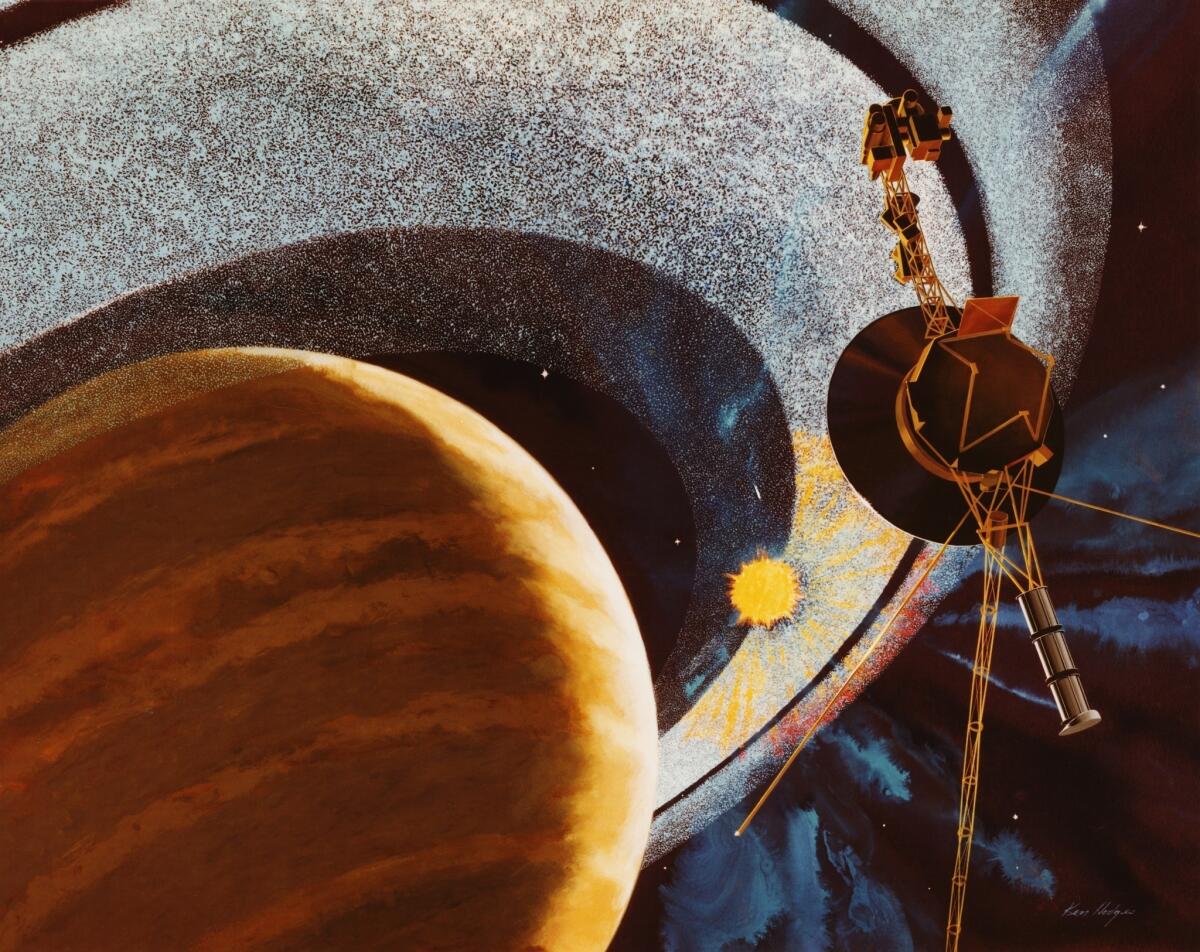Voyager, the space triumph that nearly wasn’t

- Share via
The Voyager 1 spacecraft is the first human-made object to venture into interstellar space. Even if defined only by distance, the NASA/Jet Propulsion Laboratory twin Voyagers are America’s greatest space adventure. They’ve been flying successfully for more than 36 years and are billions of miles from home. What isn’t widely known is that they almost never made it out there.
The first proposed mission in the late 1960s was for four spacecraft to take advantage of a rare alignment of the four outer planets of the solar system; Jupiter, Saturn, Uranus and Neptune would all be on the same side of the sun. However, in December 1971, NASA decided it couldn’t afford the $1-billion price tag for a 12-year “grand tour” mission with four spacecraft.
This alignment happens only every 176 years, and the next launch opportunity was just five years away, in 1977. To avoid missing the opportunity, JPL engineers quickly devised a plan to send two simpler spacecraft on four-year flights to Jupiter and Saturn, with the hope of continuing on to Uranus and Neptune.
But exploring space is hard. If something breaks, you can’t send out a mechanic. Because of the hours it takes radio signals to travel to the spacecraft, ground controllers can’t fix anything in real time. So JPL engineers had to build the smartest spacecraft yet designed, using “fault protection” programs in their small computers to spot any problems and take action. The autonomy of the two spacecraft was essential to their capability and longevity, but that also made it difficult during the first few months to learn how to fly them.
Voyager 1 was on a shorter, faster trajectory, so Voyager 2 was launched first, on Aug. 20, 1977. Shortly after launch, Voyager 2’s fault protection was put to the test. The spacecraft was tumbling and in a state of mechanical vertigo. The computer began exchanging primary systems for backups, following its fault-protection sequences. Although some engineers wanted to reboot the computer, a key engineer realized that a reset would be fatal because Voyager 2’s sun sensor had to locate and lock onto the sun to orient itself. The engineers nervously watched the data as the spacecraft righted itself and stabilized. As someone put it, Voyager 2 was “smarter than we were.”
Two weeks later, Voyager 1 had its own launch adventure but rode it out in blissful ignorance. The first-stage rocket underperformed, requiring a longer burn by the second stage to achieve the speed needed to reach Jupiter at the prescribed time. It did the job with only 3 1/2 seconds of fuel left, about the time it takes to read this paragraph. If it had run out of fuel, it would have been late for its rendezvous with Jupiter.
Wondrous encounters with Jupiter ensued in 1979. Thanks to the spacecrafts’ cameras, the Voyagers let everyone marvel at Jupiter’s orange moon Io as it spouted eight volcanic plumes, revealing it as the most geologically active object in the solar system.
Encounters with Saturn in 1980 and 1981 entranced us with images of its majestic rings and many moons. Scientists knew that its planet-sized moon Titan had an atmosphere, but they didn’t know it was mainly nitrogen and much denser than Earth’s.
In 1981, the continuation of the Voyager journey beyond Saturn, as well as NASA’s other planetary programs, were in dire danger of cancellation. But, aware of strong public interest buoyed by the illuminating images and unexpected discoveries, the White House agreed to continue the planetary program and Voyagers’ mission to Uranus.
Five years later, Voyager 2 flew past Uranus. Finally, in 1989, Voyager 2 reached Neptune, finding its winds among the fastest and strongest even though it’s the farthest from the heat of the sun.
Before Voyager 1’s cameras were turned off (to save power and memory), they looked back toward the sun, taking a photograph of tiny Earth in the black distance, the famed “pale blue dot.”
Without the Voyager mission, we wouldn’t have been able to see the diversity and splendor of our solar system up close, to answer that haunting, persistent question, “What is it like out there?” The adventure that almost didn’t happen will continue as Voyager 2 joins Voyager 1 in exploring the space between the stars, until about 2025, when power runs out. They will journey on, carrying golden records, which are time capsules of Earth where their great adventure began.
Edward C. Stone, a former director of NASA’s Jet Propulsion Laboratory, is the project scientist of NASA’s Voyager mission and a professor of physics of Caltech. “The Stuff of Dreams,” a documentary about the early years of Voyager, premieres at Caltech’s Beckman Auditorium on Feb. 19 at 7:30 p.m.
More to Read
A cure for the common opinion
Get thought-provoking perspectives with our weekly newsletter.
You may occasionally receive promotional content from the Los Angeles Times.










